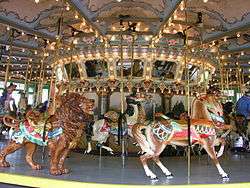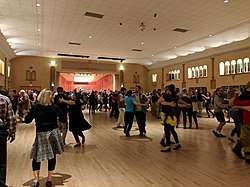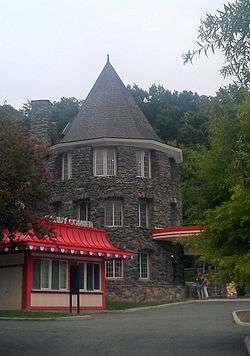Glen Echo Park, Maryland
Glen Echo Park is an arts and cultural center located in Glen Echo, Maryland that, in its former incarnation, was a popular Washington, D.C.-area amusement park that operated for several decades from the early 1900s to the 1960s. The arts and cultural center takes its name from the amusement park.
Glen Echo Park Historic District | |
  | |
| Location | 7300 MacArthur Blvd. Glen Echo, Maryland |
|---|---|
| Coordinates | 38°57′59″N 77°8′17″W |
| Area | 9 acres (3.6 ha) |
| Built | 1891 |
| Architect | Multiple |
| Architectural style | Moderne, Queen Anne, Shingle Style, Spanish Colonial Mission Revival |
| NRHP reference No. | 84001850[1] |
| Added to NRHP | June 8, 1984 |
Located roughly 9 miles (14 km) northwest from downtown Washington, D.C., the site of Glen Echo Park was originally conceived and developed as a National Chautauqua Assembly in 1891. Following the foreclosure and sale of the Chautauqua grounds in 1903, leisure facilities were then developed for the growing population of Washington, D.C. In 1911, the site was significantly expanded to become Glen Echo Amusement Park, which operated continuously until its closure in 1968.[2]
Today Glen Echo Park is one of the more important cultural resources in the Washington, D.C. area, offering hundreds of classes, workshops and performances in the visual and performing arts. The facility is well known for its Art Deco architecture, an antique Dentzel carousel, a historic Spanish Ballroom, as well as its children's theaters, social dance programs, and many public festivals, including Family Day and the Washington Folk Festival. Each year more than 400,000 people attend events and participate in instructional activities at the park. The National Park Service also offers park history tours and maintains a visitors area.
History
Chautauqua
Edwin and Edward Baltzley, inventors, industrialists, and real estate developers, hoped to build upon the banks of the Potomac River a suburban community free of the urban pollution of late-nineteenth century Washington. In order to compete with other suburban developments, the Baltzley brothers planned a series of opulent attractions for their would-be community.[3]
On February 24, 1891, the Baltzley brothers incorporated the National Chautauqua of Glen Echo, the 53rd such assembly, and immediately set to building a stone citadel of culture to complement their real estate and resort enterprises.[4] Opened on June 16, 1891,[5] their arts and culture program included lectures and concerts[6] in a 6,000-seat amphitheater;[5] special classes in Bible studies,[7] Greek, and Hebrew; physical training regimens;[8] and university extension courses. Hundreds flocked to the site to picnic, attend lectures on American history by Jane Meade Welch, courses on ancient Egypt by Lysander Dickerman, and concerts by John Philip Sousa and his band.[9] Clara Barton, encouraged by the Baltzleys, not only located her home and the American Red Cross headquarters at Glen Echo, but she presided over the Women's Executive Committee for the Chautauqua itself.[10] The inaugural season's success warranted an extension well into August.[11]
Failure
By the spring of 1892 the various Baltzley enterprises were gravely in debt. On April 7, 1892, the Glen Echo Sand and Building Company, a Baltzley subsidiary, borrowed a large sum of money giving the Chautauqua site as collateral. This was one of many Baltzley mortgages on the site. The financial difficulties spread to the Glen Echo Railroad Company, yet another Baltzley enterprise, which, because of the U.S. Army Corps of Engineers and the adjacent Washington Aqueduct system, had failed to bring the much anticipated street car service to the Chautauqua site and Glen Echo Village.[12]
Compounding their overextended credit, the Baltzley brothers found themselves the victim of common rumor. At the beginning of the 1892 season, rumor had spread throughout Washington that Glen Echo was rampant with malaria.[13] Regardless of the validity of these accusations, when combined with the brother's precarious finances, the Chautauqua site fell into disuse.[14]
Amusement park

In the early 20th century the Chautauqua site was turned into an amusement park named Glen Echo Park. The amusement park was one of the larger establishments of its type in the Washington, D.C. area, and was very popular well into the late 1940s. By the mid-1950s, however, attendance began to decline due to the growing popularity of larger regional theme parks, such as Disneyland. Another blow to the park occurred in 1960 when the trolley line from Washington, D.C. ceased operation. The amusement park managed to continue operations for a few more years, but was finally closed after the 1968 season.[15]
Segregation at the amusement park
Like many public facilities in and around the Washington area, Glen Echo Park was restricted to whites for 63 out of the first 70 years of its history. On June 30, 1960, to draw attention to the continuing segregation, a group of college students (primarily from Howard University)[16] staged a sit-in protest on the carousel.[17] Five African American students were subsequently arrested for trespassing.[15] The arrests were appealed to the Supreme Court four years later, and the convictions were reversed in Griffin v. Maryland on the grounds that the state had unconstitutionally used its police power to help a private business enforce its racial discrimination policy.[15] This led to an eleven-week civil rights campaign against Park policies with students and residents of the nearby Bannockburn community joining together to demand change. As a result, the park opened its doors to all races for the 1961 season.[18]
In 1966 on the day after Easter, bus transportation was shut down when race protests broke out.
Carousel
Carousel at Glen Echo Park | |
 Animals on the carousel | |
| Area | less than one acre |
|---|---|
| Built | 1921 |
| Architect | Dentzel, Gustav; Dentzel, William |
| Part of | Glen Echo Park Historic District (ID84001850[1]) |
| NRHP reference No. | 80000351[1] |
| Significant dates | |
| Added to NRHP | July 4, 1980 |
| Designated CP | June 8, 1993 |
The last operating park ride, and one of the highlights of the park today, is a 1921 Dentzel menagerie carousel with 38 horses, 2 chariots, 4 rabbits, 4 ostriches, a lion, a tiger, a giraffe, and a prancing deer. A Wurlitzer style 165 Band Organ (formerly a Wurlitzer style 153 band organ), provides the carousel's music. In its heyday the carousel sported an operating brass ring, in which daring riders could reach out and pull a ring out of a holder next to the carousel. Grabbing a brass ring would win the lucky rider a free ride. The brass ring arm is still visible today, although it no longer operates.[19]
The face of the carousel had changed greatly since 1921, with the animals, rounding boards, inner drum panels, and band organ receiving several new coats of paint over the years. An installation photograph from 1921, as compared to the carousel in 1983, showed an original design of the body and tack on the Indian horse that was very different from the present-day animal. Chipping away at the horse's paint revealed several strata of differently colored and styled paint jobs spanning the past sixty years, with the original 1921 paint at the bottom.
The carousel was restored by specialist Rosa Ragan, who has restored several other carousels in the United States. She restored the Indian horse by removing the park paint, exposing as much of the original paint as possible, and filling in the gaps in the original paint, a process called inpainting, before covering the horse in a protective varnish. This process, however, exposed the original paint to damage from riders, thus rendering the horse unrideable. In order to restore each animal without risking damage to the original paint, Ragan developed a new process of uncovering the original paint job, recording the colors and design, and then covering the original paint with a reversible varnish before giving the animal a white base coat and repainting it in the original colors. However, Ragan did leave a small window of original paint exposed on each animal for riders to find.
These glimpses of the original 1921 paint are called "windows to the past" and can be found on the plain side (the inward-facing side) of each animal. Ragan's 20-year restoration of the carousel completely overhauled the animals, the band organ, and the rounding boards and drum panels, returning the carousel to its original beauty and splendor.
The carousel was in a scene in the 1989 comedy Chances Are starring Robert Downey Jr. and Cybill Shepherd. The carousel was individually listed on the National Register of Historic Places in 1980.[1]
Incidents at Glen Echo Park
- June 23, 1918: The first fatality at the amusement park occurred when Joseph J. Hamel, a 43 year old stone cutter from Washington, fell from a roller-coaster (known as Gravity Railway) car while sitting on an armrest, due to overcrowding. Hamel was rushed to Georgetown Hospital but died the next day.[20][21]
- May 5, 1989, during a Friday night contra dance, the rain-swollen Minnehaha Creek overflowed its banks, and an estimated 25 vehicles were swept from the main parking lot toward the Potomac River, some of them actually ending up in the river. More than 50 vehicles were destroyed. The ultimate cause of the flash flood was a 5" rainfall upstream, at a different location than the park.[22]
Management by National Park Service
Since 1971, Glen Echo Park has been part of the National Park Service. Various renovations, backed by government funds and individual donations, have been undertaken throughout the park, notably the Spanish Ballroom, the Arcade building that now hosts art classes and art studios, and the art deco style neon sign.
Arts and cultural center
Management by Glen Echo Park Partnership for Arts and Culture
Glen Echo Park is managed by the Glen Echo Park Partnership for Arts and Culture in cooperation with Montgomery County, Maryland, and the National Park Service. Established by Montgomery County in 2002, the Partnership is a nonprofit organization charged with managing Glen Echo Park's arts programs and facilities, including its historic buildings. The Partnership's mission is to present vibrant artistic, cultural, and educational offerings at the Park and to promote the Park as a unique destination for the region's diverse population. In collaboration with Montgomery County and the National Park Service, the Partnership works with resident artists and organizations to develop distinctive arts programming; operates the historic Dentzel carousel and the Spanish Ballroom; presents an extensive social dance program; produces festivals and special events; conducts fundraising and marketing; and manages and maintains all facilities.
Resident arts programs
Glen Echo Park is home to thirteen resident artists and arts organizations. The resident artists and organizations offer classes, concerts, exhibitions, open studios hours, workshops, and lectures. Resident programs and artists include: Adventure Theatre MTC, Art Glass Center at Glen Echo, Glen Echo Glassworks, Glen Echo Pottery, J. Jordan Bruns, Photoworks, Playgroup in the Park, the Puppet Co., SilverWorks, Glen Echo Park Aquarium, Washington Conservatory of Music, Yellow Barn Studio & Gallery, and Young Creative Spirit.

Special events and concerts
The park hosts several family festivals and special events throughout the year, including Family Day (when the carousel opens for the season), Then & Wow, Labor Day Art Show, Irish Music and Dance Showcase, Washington Folk Festival,[upper-alpha 1] Fall Frolic, Contrastock,[upper-alpha 2] an extensively-decorated Halloween dance, inaugural balls, and Winter's Eve. From June through August, the Glen Echo Park Partnership presents a free summer concert series each Thursday night in the Bumper Car Pavilion.
Social dancing

Glen Echo Park offers a broad array of social dance events and classes as part of its standard programs. There are regular dances and classes in waltz, swing, contra,[23][24] and salsa. Dances take place in the historic Spanish Ballroom, the Bumper Car Pavilion, and the recently renovated, climate-controlled Ballroom Annex (The Back Room). Approximately 60,000 people attend Glen Echo Park's dances each year. A $19 million renovation of the Spanish Ballroom in 2003 returned it to its original splendor, giving it continued prominence as one of the premiere sites for dancing in the Washington DC area. The 18-month renovation was preceded by a National Park Service led, volunteer-labor makeover of the deteriorating Bumper Car Pavilion, converting it into an all-weather dance pavilion & band shell, for uninterrupted dancing through the renovation. Currently, it remains in use as an alternative dance venue and for private events, such as wedding receptions.
All social dances are open to the public, for all ages, with no prior experience or partner required. All dances offer an introductory lesson before the dance begins and most include live music. Alcohol is prohibited on park grounds, and smoking is prohibited in all buildings.
Images
Pictures of Glen Echo Park are available on Wikimedia Commons.
- The Bumpercar Pavilion
- The Cuddle Up
 Minnehaha Branch
Minnehaha Branch Crystal Pool entrance in 2007
Crystal Pool entrance in 2007 Crystal Pool entrance in 2012
Crystal Pool entrance in 2012 Chautauqua Tower
Chautauqua Tower Ballroom
Ballroom
See also
- Chautauqua Tower
- Glen Echo Park Aquarium
Footnotes
- The Washington Folk Festival is a free, two day, family-friendly celebration of the music, song, dance, and craft traditions found in the D.C. metro area.
- Contrastock, a word-play on Woodstock, is a day-long contra dance event, featuring multiple sequential bands and dance-callers.
References
- "National Register Information System". National Register of Historic Places. National Park Service. July 9, 2010.
- Gary Scott and Bill Brabham (n.d.). "National Register of Historic Places Registration: Glen Echo Park Historic District" (PDF). Maryland Historical Trust. Retrieved 2016-01-01.
- 'A Throng at Glen Echo,' "Washington Post", May 21, 1891; Richard Cook & Deborah Lange, "Glen Echo Park: A Story of Survival", Bethesda: Bethesda Communication Group, 2000, 4-8; 'Glen Echo Park Historic Structures Report', National Park Service, Department of the Interior, 1987, III-1 to III-8.
- 'Report of the Women's Executive Committee,' "The National Chautauqua of Glen Echo", Washington, DC: 1891; Richard Cook & Deborah Lange, "Glen Echo Park: A Story of Survival", Bethesda: Bethesda Communication Group, 2000, 11-15.
- "The National Chautauqua: Interesting Opening Exercises—Characteristic Address by Dr. Talmage". The Baltimore Sun. June 17, 1891. p. 4. ProQuest 535340708.
- "Delsarte and Riches: Summer Lectures in Tent and Amphitheater at Glen Echo: Talmage on the Holy Land". The Washington Post. June 18, 1891. p. 2. ProQuest 138559292.
- "Inside Closed Gates: First Sunday of the National Chautauqua". The Washington Post. June 22, 1891. p. 2. ProQuest 138576410.
- "Glen Echo Art School: Feature of the National Chautauqua Educational Course: New Manual Training Idea". The Washington Post. March 22, 1891. p. 16. ProQuest 138652620.
- 'Report of the Women's Executive Committee,' "The National Chautauqua of Glen Echo", Washington, DC: 1891; 'The Glen Echo Chautauqua', "Washington Post", June 21, 1891; 'Glen Echo Advertisement', "Washington Post", May 12, 1891; 'At Glen Echo Today', "Washington Post", June 16, 1891.
- Elizabeth Prior, "Clara Barton: Professional Angel", Philadelphia: University of Pennsylvania Press, 1987, 263-265.
- 'Ho For Glen Echo!', "Washington Post", July 29, 1891.
- 'Glen Echo Park Historic Structures Report', National Park Service, Department of the Interior, 1987, III-40 to III-54; 'Glen Echo Road to be Sold at Auction', "Washington Post", June 23, 1895.
- Richard Cook & Deborah Lange, "Glen Echo Park: A Story of Survival", Bethesda: Bethesda Communication Group, 2000, 30.
- Richard Cook & Deborah Lange, "Glen Echo Park: A Story of Survival", Bethesda: Bethesda Communication Group, 2000, 30-33; 'Glen Echo's Future', "Washington Post", July 19, 1896.
- Scharfenberg, Kirk (April 2, 1969). "Laughter Dies At Glen Echo". The Washington Post. p. C1. ProQuest 147685202.
- Glen Echo Park - Frequently Asked Questions (U.S. National Park Service)
- "Summer of Change: A Civil Rights Story". Retrieved 30 Oct 2019.
- The Washington Post, Protest on a Sculpted Horse (June 29, 2004)
- Gary Scott and Nicholas Veloz (March 1980). "National Register of Historic Places Registration: Carousel at Glen Echo Park" (PDF). Maryland Historical Trust. Retrieved 2016-01-01.
-
"State ex rel. Hamel v. Glen Echo Park Co". casetext.com. Casetext: Smarter Legal Research. 1921-01-12. Retrieved 2020-05-24.
J. Joseph Hamel by his own negligence directly contributed to the happening of the injury complained of.
- Tiffany, Herbert T. (1921). Reports of Cases Argued and Determined in the Court of Appeals, Maryland. 137. Baltimore: King Brothers. pp. 529–533.
- Fowler, Stan (2013-05-26). "Glen Echo, MD 1989 Great Flood". YouTube.com. Retrieved 2020-05-22.
Minnehaha creek overcame man-made channeling and destroyed over 50 cars, including several that made it all the way to the Potomac
- "Friday Night Dancers". Retrieved 2016-09-26.
- "Folkore Society of Greater Washington". Retrieved 2016-09-26.
External links
| Wikimedia Commons has media related to Glen Echo Park. |
- Official website
- Glen Echo Park, from the National Park Service
- Glen Echo Park: Center for Education and Recreation, a National Park Service Teaching with Historic Places (TwHP) lesson plan
- Town of Glen Echo
- Glen Echo Partnership for Arts and Culture website accessed June 12, 2007
- Glen Echo Park Historic District, Montgomery County, Inventory No.: M: 35-41, including photo in 2003, at Maryland Historical Trust website
- Carousel at Glen Echo Park, Montgomery County, Inventory No.: M: 35-39, including photo in 2003, at Maryland Historical Trust website
- Contrastock 2011 (finale)
The following are filed under 7300 MacArthur Boulevard, Glen Echo, Montgomery County, MD:
- Historic American Buildings Survey (HABS) No. MD-1080-A, "Glen Echo Park, Dentzel Carousel & Building"
- HABS No. MD-1080-B, "Glen Echo Park, Spanish Ballroom"
- HABS No. MD-1080-C, "Glen Echo Park, Arcade"
- HABS No. MD-1080-D, "Glen Echo Park, Chautauqua Tower"
- HABS No. MD-1080-E, "Glen Echo Park, Yellow Barn"
- HABS No. MD-1080-F, "Glen Echo Park, Administration Building"
- Historic American Engineering Record (HAER) No. MD-43, "Glen Echo Park, Crystal Swimming Pool"
- Historic American Landscapes Survey (HALS) No. MD-17, "Glen Echo Park"

